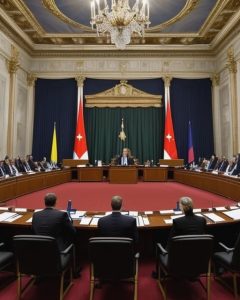The Vienna Convention is celebrated as a monumental fit of diplomatic choreography, a work of art that pulls the international community of nations together in the service of a shared vision—elusive, yet beautiful—of world diplomacy. At its core, it is a treaty that makes the code under which diplomats work a matter of international law, from how embassies and consulates are established and protected to how diplomats and consular officers themselves are treated and dealt with. The Vienna Convention is one of those rare international agreements that everyone wishes to honor. Signed and accepted by almost every country in the world, the Vienna Convention is an international agreement that outlines the rules for diplomatic relations. Most specifically, it covers the privileges and immunities that diplomats and other government officials are entitled to when serving in other countries. It is a crucial instrument for maintaining international order. But precisely because of the Convention’s lofty goals and international reach, it is also deeply mired in politics and fraught with challenges in carrying out its intended mission. Undoubtedly, it has played a part in encouraging international cooperation and the peaceful settlement of disagreements, but it has profound flaws of its own. The most serious of these is the weakness of the enforcement tools the convention relies on. Some of these tools are simply too weak to make a meaningful difference. For example, if the ICJ rules against a state but that state refuses to comply, the only thing the court can do is report the matter to the UN Security Council. However, under the council’s procedures, even that has to be unanimous, because any of the council’s five permanent members can veto the referral. The Vienna Convention’s effectiveness, not to mention its very existence, is under threat—undermined by the issues of noncompliance and state practice that it was formulated to resolve. In the face of real or perceived violations, states are increasingly inclined to either bring their concerns before international courts or tribunals or simply to renounce the Convention altogether. And even where the Convention is not formally denounced or before the court, one can observe an important shift from what G.A. Flomo calls the “traditional route” of diplomatic negotiation toward a more legalistic or litigious approach to dispute settlement.
Directing our focus now towards the domain of international law, the Vienna Convention carries the note of pre-eminence because it encompasses a virtually comprehensive framework for governing the world of diplomacy. This, in essence, is an ambitious accomplishment given the Victorians’ prescription for sovereignty in the foreign relations between states. The Vienna Convention applies to many diplomatic activities. It ensures that diplomatic premises can’t be violated, guarantees that the people working there have immunity from local laws, and, most importantly, it allows for the “unimpaired and unfettered” contact between the diplomats and their home offices. If you were to take a common-sense step back and think about it, you should be able to see the rationale behind all these provisions. Diplomacy can’t really work if the country that’s supposed to be according the defined benefits of the conventions feels like it can’t carry out its basic practices; and once diplomacy breaks down, we’re a lot closer to war. Moreover, the convention delineates the way diplomatic appointments should be made, sets forth the special status of diplomatic couriers, and determines when and under what circumstances a diplomatic mission may be terminated. By doing so, it helps ensure the mutual recognition of the diplomatic proceedings among states and is a major factor for the peaceful resolution of disputes that may arise in the context of a diplomatic incident, ensures the proper functioning of a diplomatic mission, and even sometimes can be helpful for the maintenance of international relations!
To sum up, the Vienna Convention is a vital structure in the overall architecture of international relations. Why? For the clear reason that it serves the multiple and diverse interests of the many nations of the world. All of them simply cannot afford to fall into disorder—that would be chaos. They must have rules that establish order for them in the ways that they relate to each other. However, as this paper has made clear, the Convivencia is diminished in its power in the real world mainly for two reasons. The first is that the mechanics of enforcing these difficult distinctions seldom work, so that what looks good on paper seldom works in actual practice in the international scene. The second is that in terms of real power, some states dominate others, so that they can usually get away with doing what they want. Regardless of the foregoing, the Vienna Convention is a shining light of what might be in terms of social agreements transcending all the contentious issues of state sovereignty—some of which nearly derailed it—and it is still here in force today, with 193 states party to some part of it. There is good reason to believe that it helped avoid the worst excesses of irrational and self-defeating outcomes that could have resulted from the treaty negotiation styles of certain states. It also might have helped move the world in directions of self-transcendence when it has been necessary to contemplate changes that were not yet part of historical experience. By taking this step, we assert our dedication to the virtues of cooperation and peace that the Vienna Convention memorializes so effectively. We do so with the sincere hope that nations will conduct their diplomatic affairs in a manner that aspires to the same ideals of treating friends as friends and enemies as enemies; of communicating honestly, directly, and in good faith; and of, when all else fails, using coercion only as a last resort and only when justified by law.

